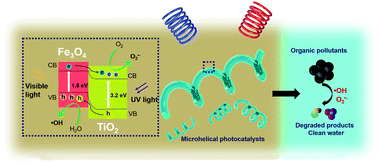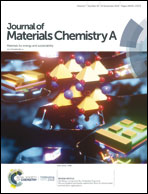On-the-fly catalytic degradation of organic pollutants using magneto-photoresponsive bacteria-templated microcleaners†
Abstract
Increasing accumulation of highly persistent and non-biodegradable organic pollutants in our fresh water sources imposes a threat to human health. Designing novel catalytic materials that can efficiently harness energy from their surroundings to degrade such problematic pollutants is essential. In this work, we fabricated core–shell microhelical robots composed of iron oxide@titanium dioxide (Fe3O4@TiO2) for UV-visible light driven degradation of organic pollutants in a cost-effective manner. Bio-templating and sol–gel synthesis were employed for a simplified approach to batch-fabricate magnetic photocatalysts. These hybrid microrobots removed 97% of RhB dye from contaminated water in 75 minutes using UV-visible light (k-value of 0.047 min−1). Furthermore, when photocatalytic degradation was performed under continuous magnetic field driven propulsion, 99% of RhB dye degraded in 40 minutes with a k-value of 0.108 min−1. We also observed a strong correlation between the hybrid microhelices' swimming characteristics and their subsequent photocatalytic degradation efficiency. These results were further corroborated using COMSOL simulations.



 Please wait while we load your content...
Please wait while we load your content...